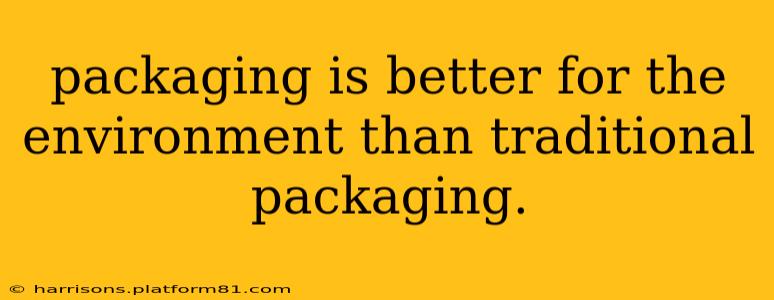The question of whether sustainable packaging is truly "better" for the environment than traditional packaging is complex. While the ideal scenario is a complete elimination of packaging waste, that's not currently realistic. The reality is a spectrum, with some sustainable options offering significant improvements over traditional materials, while others present their own set of environmental challenges. This article will delve into the specifics, exploring the advantages and disadvantages of both to provide a clearer picture.
What is Considered "Traditional" Packaging?
Before we compare, it's crucial to define "traditional" packaging. Generally, this refers to materials like:
- Plastics (Polyethylene, Polypropylene, PVC, etc.): These are widely used due to their low cost, durability, and versatility but are notorious for their slow decomposition rates and contribution to plastic pollution.
- Expanded Polystyrene (EPS or Styrofoam): Lightweight and excellent for insulation, Styrofoam is incredibly difficult to recycle and contributes significantly to landfill waste.
- Paper and Cardboard (Unrecycled or minimally recycled): While biodegradable, the production of virgin paper pulp requires significant energy and water resources, and often involves deforestation.
These traditional materials, while functional, often come with significant environmental drawbacks.
What Constitutes "Sustainable" Packaging?
Sustainable packaging aims to minimize its environmental impact throughout its lifecycle, from material sourcing to disposal. Examples include:
- Bioplastics (PLA, PHA): Made from renewable resources like corn starch or sugarcane, these bioplastics can be composted under the right conditions.
- Recycled Paper and Cardboard: Using recycled materials significantly reduces the environmental burden compared to virgin materials.
- Compostable Packaging: Designed to break down completely in industrial composting facilities, leaving behind minimal residue.
- Reusable Packaging: Containers designed for multiple uses, drastically reducing the need for single-use packaging.
- Packaging Made from Recycled Materials (e.g., Ocean Plastic): Giving waste materials a second life.
Is Sustainable Packaging Always Better? The Nuances
While sustainable packaging offers numerous advantages, it's not a universally superior solution. Consider these points:
Transportation and Production:
- Weight and Volume: Some sustainable materials, like certain bioplastics, might be heavier or bulkier than their traditional counterparts, leading to increased transportation costs and emissions.
- Energy Consumption: The production of some sustainable materials can be energy-intensive, negating some of the environmental benefits.
Recycling Infrastructure:
- Accessibility: The effectiveness of sustainable packaging depends heavily on the availability of adequate recycling and composting facilities. Many compostable materials require specific industrial composting, not home composting.
- Contamination: Improper sorting and contamination can render otherwise recyclable materials unrecyclable.
Material Properties:
- Durability: Some sustainable materials may not offer the same level of protection and durability as traditional plastics, potentially leading to spoilage or damage of goods.
- Cost: Sustainable alternatives can be more expensive than traditional packaging options, making them less accessible to some businesses.
What are the Environmental Impacts of Different Packaging Types?
This is a complex question requiring consideration of the entire lifecycle. Each packaging type has its own carbon footprint, water usage, and waste generation profile. Life cycle assessments (LCAs) are used to compare these impacts. Generally, however, sustainable alternatives are considered more environmentally friendly, provided they are properly managed and recycled.
How Can I Choose More Environmentally Friendly Packaging?
- Reduce: Minimize the amount of packaging used.
- Reuse: Opt for reusable containers whenever possible.
- Recycle: Properly sort and recycle packaging according to local guidelines.
- Choose Sustainable Materials: Look for products using recycled content or compostable options.
- Support Companies Committed to Sustainability: Companies that prioritize sustainable practices are key to driving change.
Conclusion
In conclusion, while "sustainable" packaging often presents a significant environmental improvement over traditional packaging, it's not a simple case of one being universally better. The environmental impact of any packaging material is complex and depends on various factors, including material sourcing, manufacturing process, transportation, usage, and end-of-life management. Choosing the most environmentally responsible packaging option requires considering the entire lifecycle and prioritizing a reduction in overall waste.
